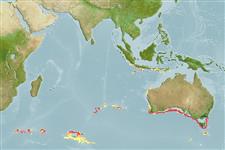Klassifizierung / Names
Namen | Synonyme | Catalog of Fishes(Gattung, Arten) | ITIS | CoL | WoRMS | Cloffa
Environment: milieu / climate zone / depth range / distribution range
Ökologie
seewasser bathydemersal; tiefenbereich 548 - 1170 m (Ref. 78434). Temperate
Eastern Indian Ocean: southern Australia.
Size / Gewicht / Alter
Maturity: Lm ? range ? - ? cm
Max length : 41.2 cm SL Männchen/unbestimmt; (Ref. 78434)
Kurzbeschreibung
Morphologie | Morphometrie
Rückenflossenstacheln (insgesamt): 6 - 7; Rückenflossenweichstrahlen (insgesamt): 15-18; Afterflossenweichstrahlen: 12 - 14; Wirbelzahl: 31 - 32. This species is distinguished by the following characters: cirri on the head; well-developed thin and flexible orbital rims; cranial (frontal) arch 3 high and twisted upwards, continuous band of prevomerine teeth; one terminal chin pore; obsolete lateral line pores; overall pale colour (Ref. 78434)..
Life cycle and mating behavior
Geschlechtsreife | Fortpflanzung | Ablaichen | Eier | Fecundity | Larven
Jackson, K.L. and J.S. Nelson, 2006. Ebinania australiae, a new species of fathead sculpin from Southern Australia (Scorpaeniformes: Psychrolutidae). Records of the Australian Museum (2006) 58:37-42. (Ref. 78434)
IUCN Rote Liste Status (Ref. 130435)
Bedrohung für Menschen
Harmless
Nutzung durch Menschen
Mehr Information
NamenSynonymeMetabolismusRäuberÖkotoxikologieFortpflanzungGeschlechtsreifeAblaichenSpawning aggregationFecundityEierEientwicklung
Alter/GrößeWachstumLänge-GewichtLänge-LängeLängenhäufigkeitenMorphometrieMorphologieLarvenLarven Pop.Dyn.RekrutierungDichteBRUVS
ReferenzenAquakulturAquakultur ProfilZuchtlinienGenetikElectrophoresesVererbbarkeitKrankheitenVerarbeitungNutrientsMass conversion
PartnerBilderStamps, Coins Misc.LauteCiguateraGeschwindigkeitSchwimmstilKiemenoberflächeOtolithsGehirngrößeSehfähigkeit
Tools
Zusatzinformationen
Download XML
Internet Quellen
Estimates based on models
Preferred temperature (Ref.
123201): 1.7 - 6.7, mean 5.7 °C (based on 20 cells).
Phylogenetic diversity index (Ref.
82804): PD
50 = 0.5078 [Uniqueness, from 0.5 = low to 2.0 = high].
Bayesian length-weight: a=0.00389 (0.00180 - 0.00842), b=3.12 (2.94 - 3.30), in cm total length, based on all LWR estimates for this body shape (Ref.
93245).
Trophic level (Ref.
69278): 3.5 ±0.3 se; based on size and trophs of closest relatives
Fishing Vulnerability (Ref.
59153): Moderate vulnerability (40 of 100).
